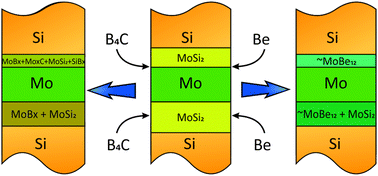Inhibition of chemical interaction of molybdenum and silicon in a Mo/Si multilayer structure by the formation of intermediate compounds
Abstract
In the present study, the formation of intermediate compounds in the Mo/Si multilayer was realized by the introduction of barrier layers at the interfaces. Their impact on the interdiffusion of Mo and Si was analyzed via X-ray photoelectron spectroscopy. It was established that the insertion of a thin Be barrier layer led to the formation of beryllide MoBe12 at the interface Si-on-Mo, which prevented the formation of molybdenum disilicide and improved the interface. The insertion of the B4C barrier layer led to its complete decomposition with the formation of borides and carbides of molybdenum and silicon (MoBx, SiBx, MoxC and SiCx) at the Si-on-Mo interface. The formation of only MoBx and SiCx was detected at the Mo-on-Si interface. It was important that the insertion of a thin B4C barrier layer did not fully prevent the formation of MoSi2 at both (Si-on-Mo and Mo-on-Si) the interfaces. These facts allowed us to assume that the diffusion barrier function of the B4C interlayer could be caused by the stability of the formed compounds, rather than the stability of the B4C layer itself.



 Please wait while we load your content...
Please wait while we load your content...